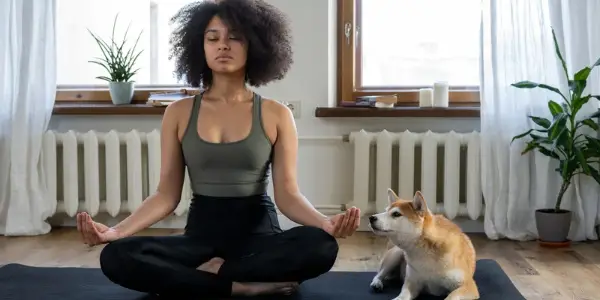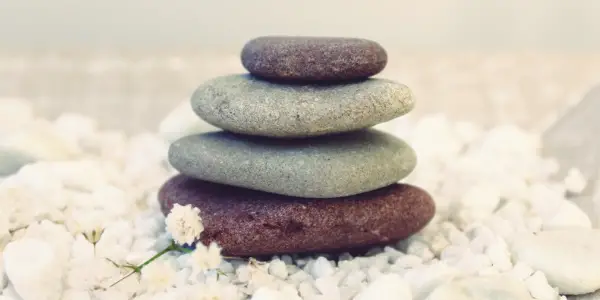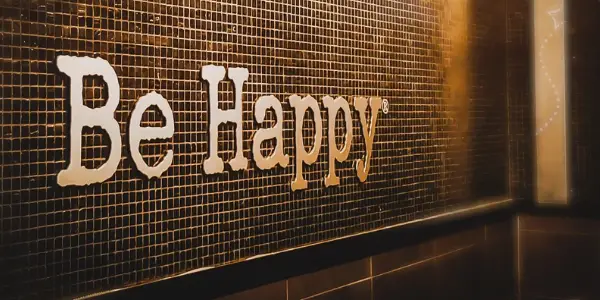So, you’ve been thinking about beginning meditation. How could you not when it seems that everywhere you turn: blogs, podcasts, celebrity interviews, friends, and co-workers are talking about the benefits of meditation?
But one quick question: If it’s so great, why aren’t we all meditating on the regular? There are likely many reasons, but one has to be that there is just no time for it when you have kids, a job, and a mile-long to-do list. I certainly resisted meditation for a very long time.
However, after a particularly stressful period in my life where I was exhausted at all times (and found myself randomly crying for no apparent reason), I decided to start learning about meditation.

False Starts
I first tried some guided meditation videos on YouTube. While some of them made me feel relaxed while listening, I didn’t see any progress in my ability to concentrate, calm myself, or regularly feel better.
Next, I joined Headspace, a meditation app, and started trying to meditate with that. Headspace focuses mainly on breathing and mindfulness exercises (based on my limited experience) and has nearly a million positive reviews. But for reasons I don’t understand, I couldn’t get into it and wasn’t consistent.
Then, one day I was listening to my favorite podcast, The Human Upgrade by Dave Asprey. He had Emily Fletcher, a meditation expert, on the show to talk about her meditation technique. She spoke about her book, Stress Less, Accomplish More, which I immediately downloaded and read in a hurry. She’s helped thousands of busy people achieve better performance through meditation, and I am all about that!
The Technique
I read the book in record time and was determined to give her method a try. The technique is relatively simple, but the book is so helpful in explaining why meditation is so important and provides a laundry list of benefits she and her clients have experienced using this meditation technique.
To summarize the technique taught in the book (called the Z-technique, adapted from the method Emily teaches live called Ziva meditation), there are three parts: mindfulness, meditation, and manifestation.
The technique begins with 2-3 minutes of a mindfulness exercise to become completely present. After that, you do 12-13 minutes of meditation, focusing your mind on one word or sound (like “one”) and allowing your body to relax deeply. Most of the time is spent in this meditation phase, where you release stress, including past stress that has been weighing on you. Finally, do 2-3 minutes of gratitude and manifestation, which includes remembering things you are great full for and visualizing future success in whatever area is most important to you.
So, if you add that up, it’s about 17 minutes, and you do the whole routine twice daily. When I first read this, I immediately thought, how am I going to find 34 free minutes in my day?? I can barely find time to work out or brush my teeth properly.
However, Emily is so convincing about all the benefits of meditating that I committed to trying it.

My Experience
Getting started was challenging to say the least. As I mentioned, my life is busy. And by busy, I mean nearly every minute is accounted for between my work responsibilities, mom responsibilities, wife responsibilities, and doing basic things to take care of myself, such as exercise, going to the dentist, and getting my hair cut.
Some initial difficulties included:
- It was challenging to fit it in twice a day consistently. It took many tries to fit meditation into my daily schedule.
- At first, I had a tough time finding a place to meditate while at work. I have an office, but there are internal windows, and I didn’t want co-workers to think I was napping. There are also conference rooms, but it was difficult for me to feel relaxed meditating in one. I now go to my car to meditate, and sometimes it works wonderfully, but other times I can’t get comfortable.
- Sometimes when I try to meditate, I can’t get my mind away from my to-do list or other anxiety-inducing events happening in my life. I go through the whole 3-part exercise, but my mind is just planning and thinking, and I don’t come out of it with that good calm vibe that is so amazing after you have a good meditation.
I’ve now been meditating for about three months, and here’s what I’ve experienced:
- When you begin meditation, Emily warns about an adjustment period where your body goes through a couple of weeks of detoxing bad stress. She warns that you might experience this as unusual emotions, bad dreams, moodiness, or reactive behavior. I experienced this for an extended period – like 4-5 weeks. I cried a lot. I felt numb. I was often in a daze and started to think this meditating thing was not for me. Luckily after that period, those sad feelings began to pass.
- I started to feel lighter. I started noticing my reactions to things and became calmer and more in tune with others. In some difficult and stressful situations, it felt like I was just an observer and did not join in a heated conversation.
- I’ve always been an anxious person (and still am), but it feels significantly less intense. I’ve noticed myself not worrying about situations that I used to. A perfect example is when I went on vacation with my family. Transportation is typically a significant stressor for me. Planes, trains, and cab rides tend to make me grit my teeth and worry. I can’t wait for the ride to be over. On this trip, I enjoyed the rides, and my husband even commented that I didn’t seem worried about the flight. A few weeks later, I went on a trip with my sister, and she also asked where my fear of flying went.
- My mind is a little bit clearer. I’m able to concentrate better with less mental background noise.
- I’m sleeping better according to my Oura ring, and I wake up feeling calmer and more peaceful.
- I can calm myself down more quickly, even outside of the meditation.
- I generally feel better and less tense.
Emily mentions a few things in the book that I have not yet experienced:
- I haven’t noticed any of the aging backward noted in the book, such as less grey hair or fewer wrinkles.
- I don’t think I’ve experienced this feeling of bliss where you are so deep into your meditation you lose track of time and yourself.
I plan to keep meditating and commit to at least once daily. I will make an effort to do it twice per day because I do feel the benefits when practicing twice per day.

Meditation has improved my daily life
Hopefully, this honest assessment of meditation using Emily Fletcher’s Z-Technique has been helpful. Since I am a high anxiety and type A personality, it has taken me longer to get the hang of meditation, but Emily’s book gives a clear plan for how and when to meditate.
As I practice more and get better at meditation, I look forward to more peace and happiness in my life. I am thankful for this technique and how it has improved my life!
Next, check out this post on mindfulness affirmations.


